Microeconomics Assignment: Elasticity, Costs, and Returns
VerifiedAdded on 2023/01/11
|7
|1230
|73
Homework Assignment
AI Summary
This microeconomics assignment solution addresses four key questions. The first question explores the impact of elastic and inelastic demand on pricing strategies. The second analyzes factors determining supply elasticity, including time to produce, resource availability, and the number of producers. The third question defines opportunity cost and argues for specialization based on comparative advantage. Finally, the fourth question examines the law of diminishing returns, explaining its relevance at low production levels and the eventual decline in returns. The assignment draws upon economic principles and provides examples to illustrate the concepts.
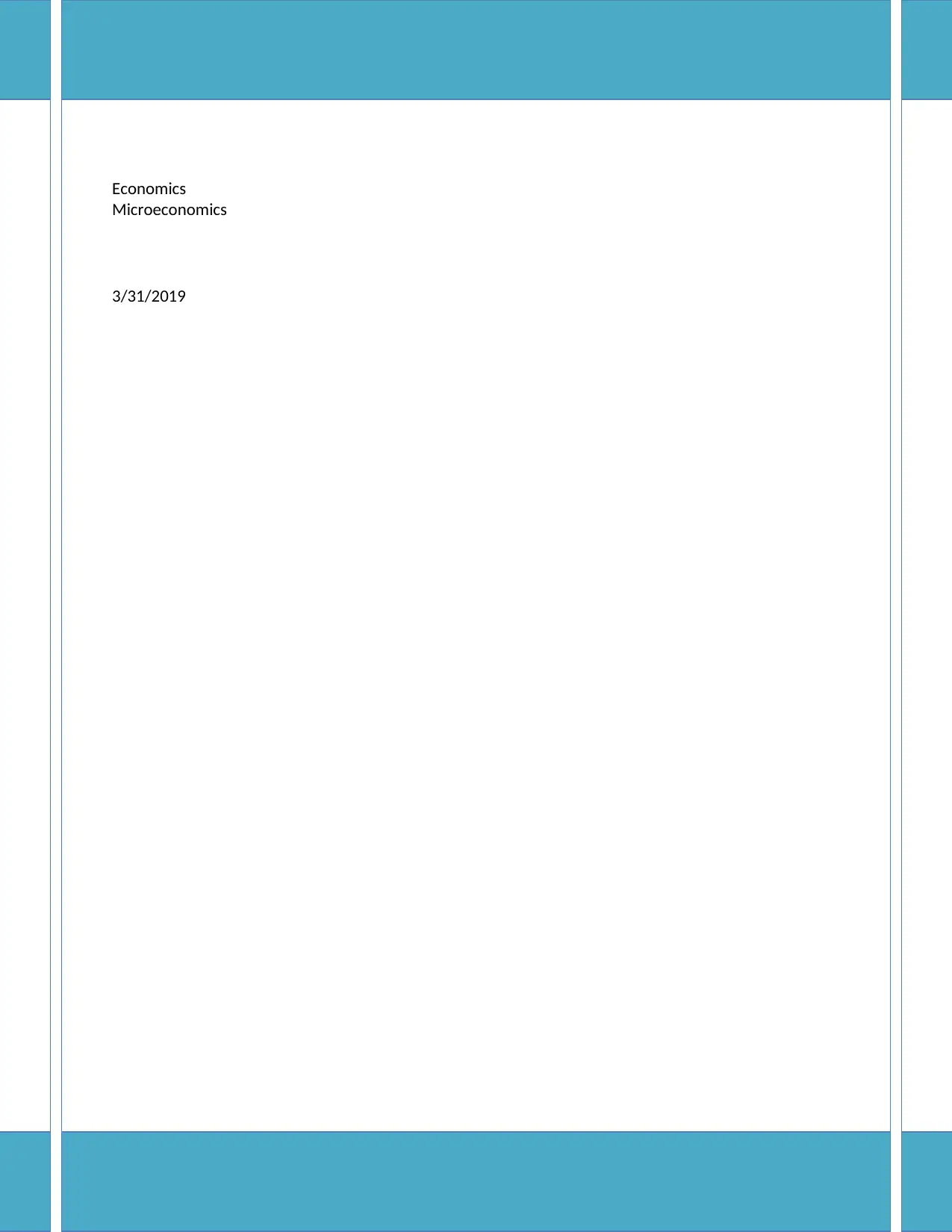
Economics
Microeconomics
3/31/2019
Microeconomics
3/31/2019
Paraphrase This Document
Need a fresh take? Get an instant paraphrase of this document with our AI Paraphraser
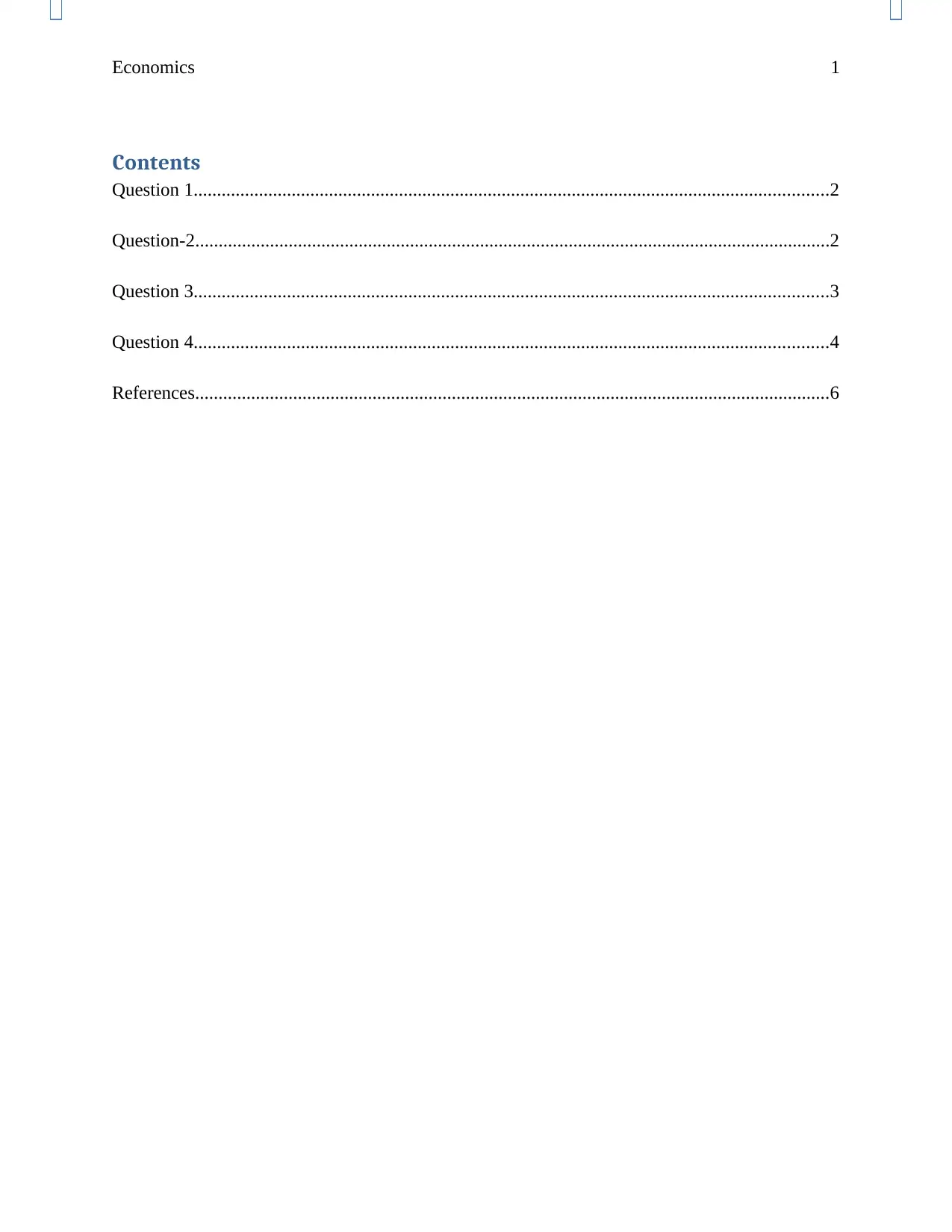
Economics 1
Contents
Question 1........................................................................................................................................2
Question-2........................................................................................................................................2
Question 3........................................................................................................................................3
Question 4........................................................................................................................................4
References........................................................................................................................................6
Contents
Question 1........................................................................................................................................2
Question-2........................................................................................................................................2
Question 3........................................................................................................................................3
Question 4........................................................................................................................................4
References........................................................................................................................................6
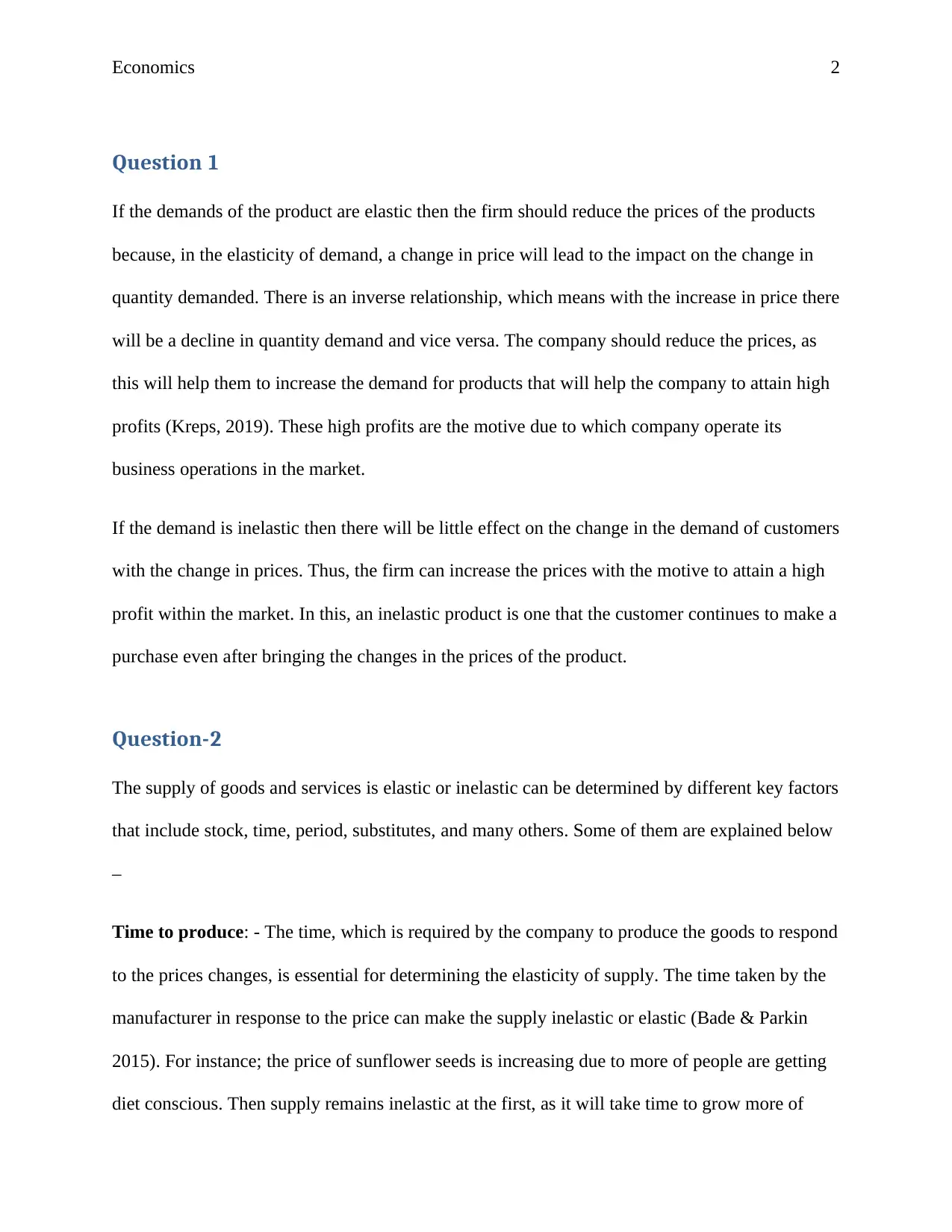
Economics 2
Question 1
If the demands of the product are elastic then the firm should reduce the prices of the products
because, in the elasticity of demand, a change in price will lead to the impact on the change in
quantity demanded. There is an inverse relationship, which means with the increase in price there
will be a decline in quantity demand and vice versa. The company should reduce the prices, as
this will help them to increase the demand for products that will help the company to attain high
profits (Kreps, 2019). These high profits are the motive due to which company operate its
business operations in the market.
If the demand is inelastic then there will be little effect on the change in the demand of customers
with the change in prices. Thus, the firm can increase the prices with the motive to attain a high
profit within the market. In this, an inelastic product is one that the customer continues to make a
purchase even after bringing the changes in the prices of the product.
Question-2
The supply of goods and services is elastic or inelastic can be determined by different key factors
that include stock, time, period, substitutes, and many others. Some of them are explained below
–
Time to produce: - The time, which is required by the company to produce the goods to respond
to the prices changes, is essential for determining the elasticity of supply. The time taken by the
manufacturer in response to the price can make the supply inelastic or elastic (Bade & Parkin
2015). For instance; the price of sunflower seeds is increasing due to more of people are getting
diet conscious. Then supply remains inelastic at the first, as it will take time to grow more of
Question 1
If the demands of the product are elastic then the firm should reduce the prices of the products
because, in the elasticity of demand, a change in price will lead to the impact on the change in
quantity demanded. There is an inverse relationship, which means with the increase in price there
will be a decline in quantity demand and vice versa. The company should reduce the prices, as
this will help them to increase the demand for products that will help the company to attain high
profits (Kreps, 2019). These high profits are the motive due to which company operate its
business operations in the market.
If the demand is inelastic then there will be little effect on the change in the demand of customers
with the change in prices. Thus, the firm can increase the prices with the motive to attain a high
profit within the market. In this, an inelastic product is one that the customer continues to make a
purchase even after bringing the changes in the prices of the product.
Question-2
The supply of goods and services is elastic or inelastic can be determined by different key factors
that include stock, time, period, substitutes, and many others. Some of them are explained below
–
Time to produce: - The time, which is required by the company to produce the goods to respond
to the prices changes, is essential for determining the elasticity of supply. The time taken by the
manufacturer in response to the price can make the supply inelastic or elastic (Bade & Parkin
2015). For instance; the price of sunflower seeds is increasing due to more of people are getting
diet conscious. Then supply remains inelastic at the first, as it will take time to grow more of
⊘ This is a preview!⊘
Do you want full access?
Subscribe today to unlock all pages.

Trusted by 1+ million students worldwide
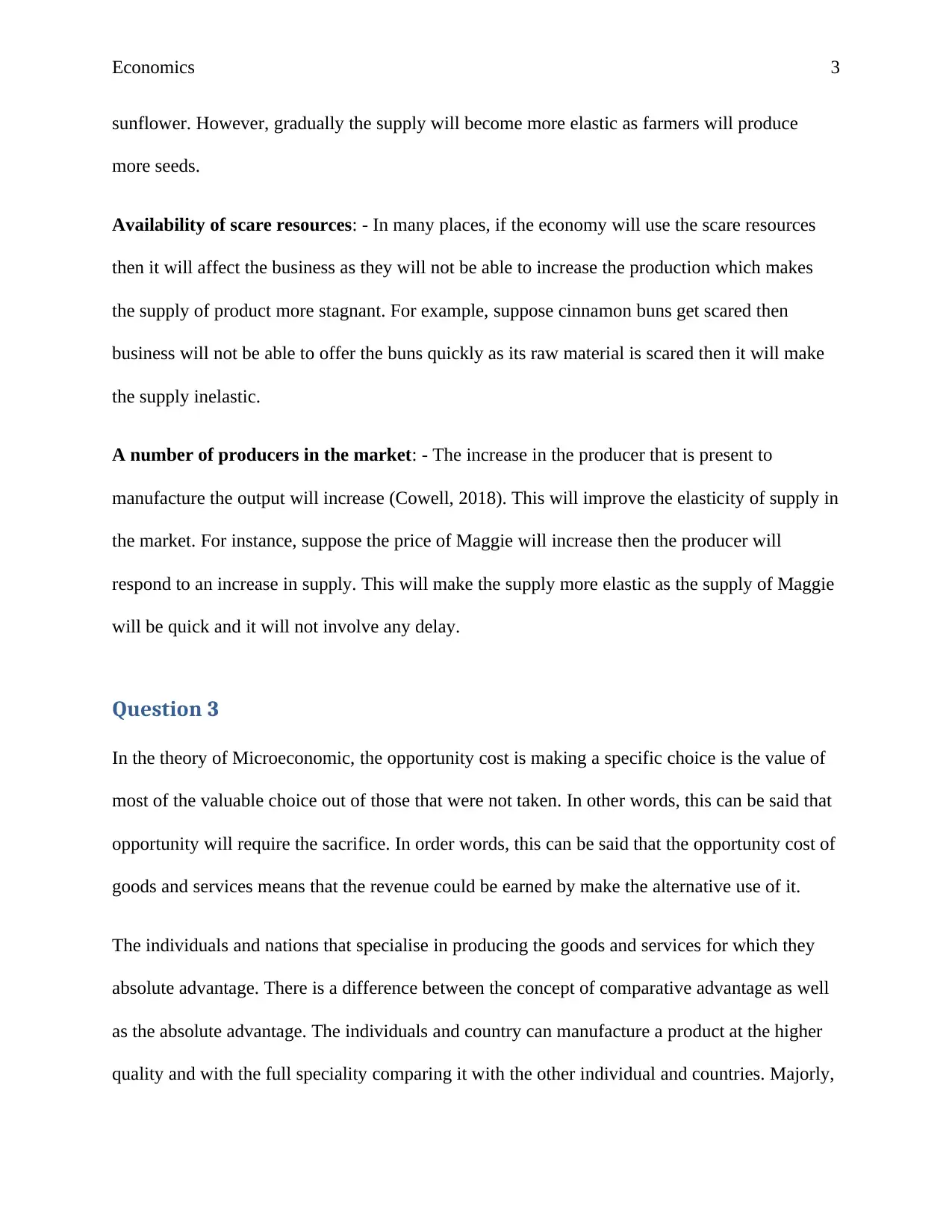
Economics 3
sunflower. However, gradually the supply will become more elastic as farmers will produce
more seeds.
Availability of scare resources: - In many places, if the economy will use the scare resources
then it will affect the business as they will not be able to increase the production which makes
the supply of product more stagnant. For example, suppose cinnamon buns get scared then
business will not be able to offer the buns quickly as its raw material is scared then it will make
the supply inelastic.
A number of producers in the market: - The increase in the producer that is present to
manufacture the output will increase (Cowell, 2018). This will improve the elasticity of supply in
the market. For instance, suppose the price of Maggie will increase then the producer will
respond to an increase in supply. This will make the supply more elastic as the supply of Maggie
will be quick and it will not involve any delay.
Question 3
In the theory of Microeconomic, the opportunity cost is making a specific choice is the value of
most of the valuable choice out of those that were not taken. In other words, this can be said that
opportunity will require the sacrifice. In order words, this can be said that the opportunity cost of
goods and services means that the revenue could be earned by make the alternative use of it.
The individuals and nations that specialise in producing the goods and services for which they
absolute advantage. There is a difference between the concept of comparative advantage as well
as the absolute advantage. The individuals and country can manufacture a product at the higher
quality and with the full speciality comparing it with the other individual and countries. Majorly,
sunflower. However, gradually the supply will become more elastic as farmers will produce
more seeds.
Availability of scare resources: - In many places, if the economy will use the scare resources
then it will affect the business as they will not be able to increase the production which makes
the supply of product more stagnant. For example, suppose cinnamon buns get scared then
business will not be able to offer the buns quickly as its raw material is scared then it will make
the supply inelastic.
A number of producers in the market: - The increase in the producer that is present to
manufacture the output will increase (Cowell, 2018). This will improve the elasticity of supply in
the market. For instance, suppose the price of Maggie will increase then the producer will
respond to an increase in supply. This will make the supply more elastic as the supply of Maggie
will be quick and it will not involve any delay.
Question 3
In the theory of Microeconomic, the opportunity cost is making a specific choice is the value of
most of the valuable choice out of those that were not taken. In other words, this can be said that
opportunity will require the sacrifice. In order words, this can be said that the opportunity cost of
goods and services means that the revenue could be earned by make the alternative use of it.
The individuals and nations that specialise in producing the goods and services for which they
absolute advantage. There is a difference between the concept of comparative advantage as well
as the absolute advantage. The individuals and country can manufacture a product at the higher
quality and with the full speciality comparing it with the other individual and countries. Majorly,
Paraphrase This Document
Need a fresh take? Get an instant paraphrase of this document with our AI Paraphraser
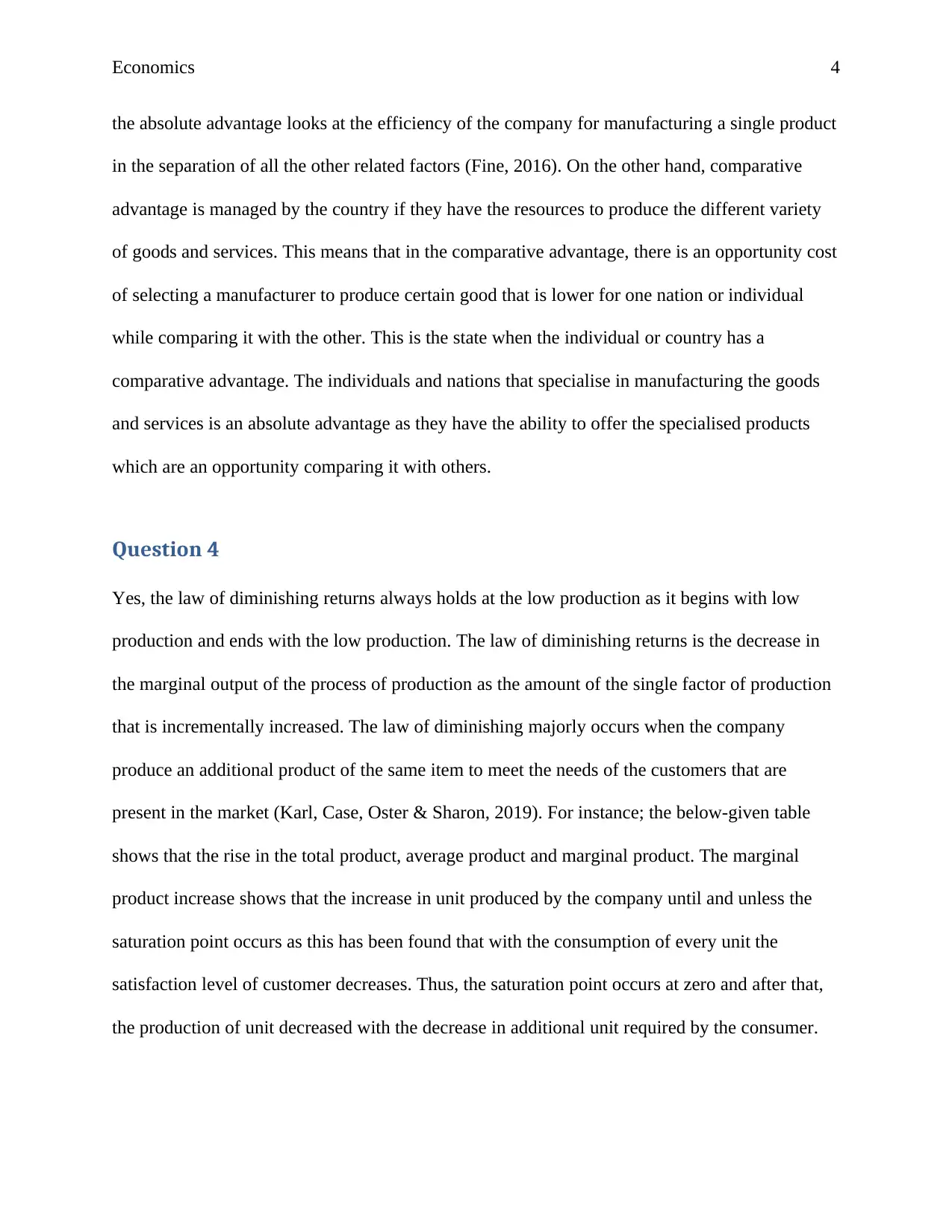
Economics 4
the absolute advantage looks at the efficiency of the company for manufacturing a single product
in the separation of all the other related factors (Fine, 2016). On the other hand, comparative
advantage is managed by the country if they have the resources to produce the different variety
of goods and services. This means that in the comparative advantage, there is an opportunity cost
of selecting a manufacturer to produce certain good that is lower for one nation or individual
while comparing it with the other. This is the state when the individual or country has a
comparative advantage. The individuals and nations that specialise in manufacturing the goods
and services is an absolute advantage as they have the ability to offer the specialised products
which are an opportunity comparing it with others.
Question 4
Yes, the law of diminishing returns always holds at the low production as it begins with low
production and ends with the low production. The law of diminishing returns is the decrease in
the marginal output of the process of production as the amount of the single factor of production
that is incrementally increased. The law of diminishing majorly occurs when the company
produce an additional product of the same item to meet the needs of the customers that are
present in the market (Karl, Case, Oster & Sharon, 2019). For instance; the below-given table
shows that the rise in the total product, average product and marginal product. The marginal
product increase shows that the increase in unit produced by the company until and unless the
saturation point occurs as this has been found that with the consumption of every unit the
satisfaction level of customer decreases. Thus, the saturation point occurs at zero and after that,
the production of unit decreased with the decrease in additional unit required by the consumer.
the absolute advantage looks at the efficiency of the company for manufacturing a single product
in the separation of all the other related factors (Fine, 2016). On the other hand, comparative
advantage is managed by the country if they have the resources to produce the different variety
of goods and services. This means that in the comparative advantage, there is an opportunity cost
of selecting a manufacturer to produce certain good that is lower for one nation or individual
while comparing it with the other. This is the state when the individual or country has a
comparative advantage. The individuals and nations that specialise in manufacturing the goods
and services is an absolute advantage as they have the ability to offer the specialised products
which are an opportunity comparing it with others.
Question 4
Yes, the law of diminishing returns always holds at the low production as it begins with low
production and ends with the low production. The law of diminishing returns is the decrease in
the marginal output of the process of production as the amount of the single factor of production
that is incrementally increased. The law of diminishing majorly occurs when the company
produce an additional product of the same item to meet the needs of the customers that are
present in the market (Karl, Case, Oster & Sharon, 2019). For instance; the below-given table
shows that the rise in the total product, average product and marginal product. The marginal
product increase shows that the increase in unit produced by the company until and unless the
saturation point occurs as this has been found that with the consumption of every unit the
satisfaction level of customer decreases. Thus, the saturation point occurs at zero and after that,
the production of unit decreased with the decrease in additional unit required by the consumer.
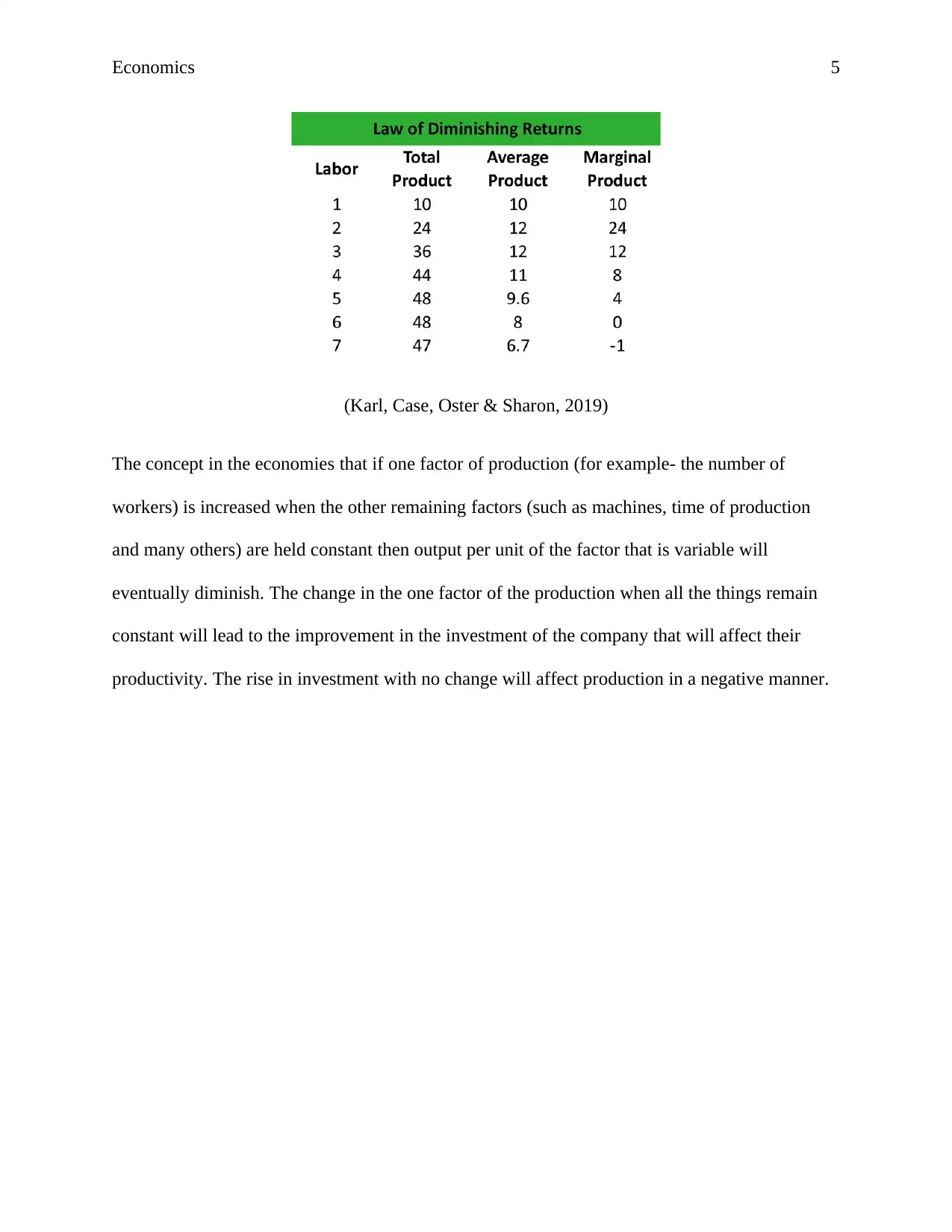
Economics 5
(Karl, Case, Oster & Sharon, 2019)
The concept in the economies that if one factor of production (for example- the number of
workers) is increased when the other remaining factors (such as machines, time of production
and many others) are held constant then output per unit of the factor that is variable will
eventually diminish. The change in the one factor of the production when all the things remain
constant will lead to the improvement in the investment of the company that will affect their
productivity. The rise in investment with no change will affect production in a negative manner.
(Karl, Case, Oster & Sharon, 2019)
The concept in the economies that if one factor of production (for example- the number of
workers) is increased when the other remaining factors (such as machines, time of production
and many others) are held constant then output per unit of the factor that is variable will
eventually diminish. The change in the one factor of the production when all the things remain
constant will lead to the improvement in the investment of the company that will affect their
productivity. The rise in investment with no change will affect production in a negative manner.
⊘ This is a preview!⊘
Do you want full access?
Subscribe today to unlock all pages.

Trusted by 1+ million students worldwide
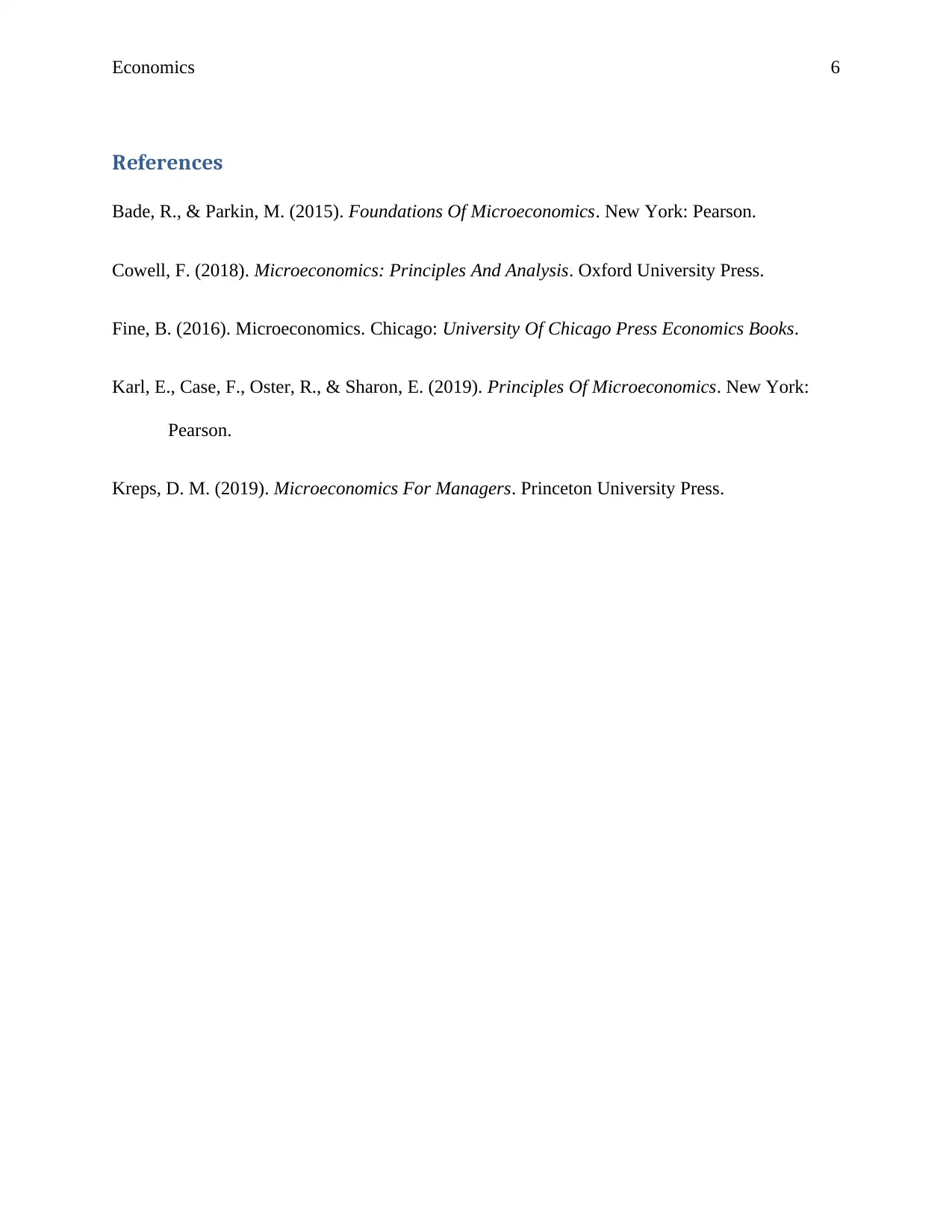
Economics 6
References
Bade, R., & Parkin, M. (2015). Foundations Of Microeconomics. New York: Pearson.
Cowell, F. (2018). Microeconomics: Principles And Analysis. Oxford University Press.
Fine, B. (2016). Microeconomics. Chicago: University Of Chicago Press Economics Books.
Karl, E., Case, F., Oster, R., & Sharon, E. (2019). Principles Of Microeconomics. New York:
Pearson.
Kreps, D. M. (2019). Microeconomics For Managers. Princeton University Press.
References
Bade, R., & Parkin, M. (2015). Foundations Of Microeconomics. New York: Pearson.
Cowell, F. (2018). Microeconomics: Principles And Analysis. Oxford University Press.
Fine, B. (2016). Microeconomics. Chicago: University Of Chicago Press Economics Books.
Karl, E., Case, F., Oster, R., & Sharon, E. (2019). Principles Of Microeconomics. New York:
Pearson.
Kreps, D. M. (2019). Microeconomics For Managers. Princeton University Press.
1 out of 7
Related Documents
Your All-in-One AI-Powered Toolkit for Academic Success.
+13062052269
info@desklib.com
Available 24*7 on WhatsApp / Email
![[object Object]](/_next/static/media/star-bottom.7253800d.svg)
Unlock your academic potential
Copyright © 2020–2025 A2Z Services. All Rights Reserved. Developed and managed by ZUCOL.




